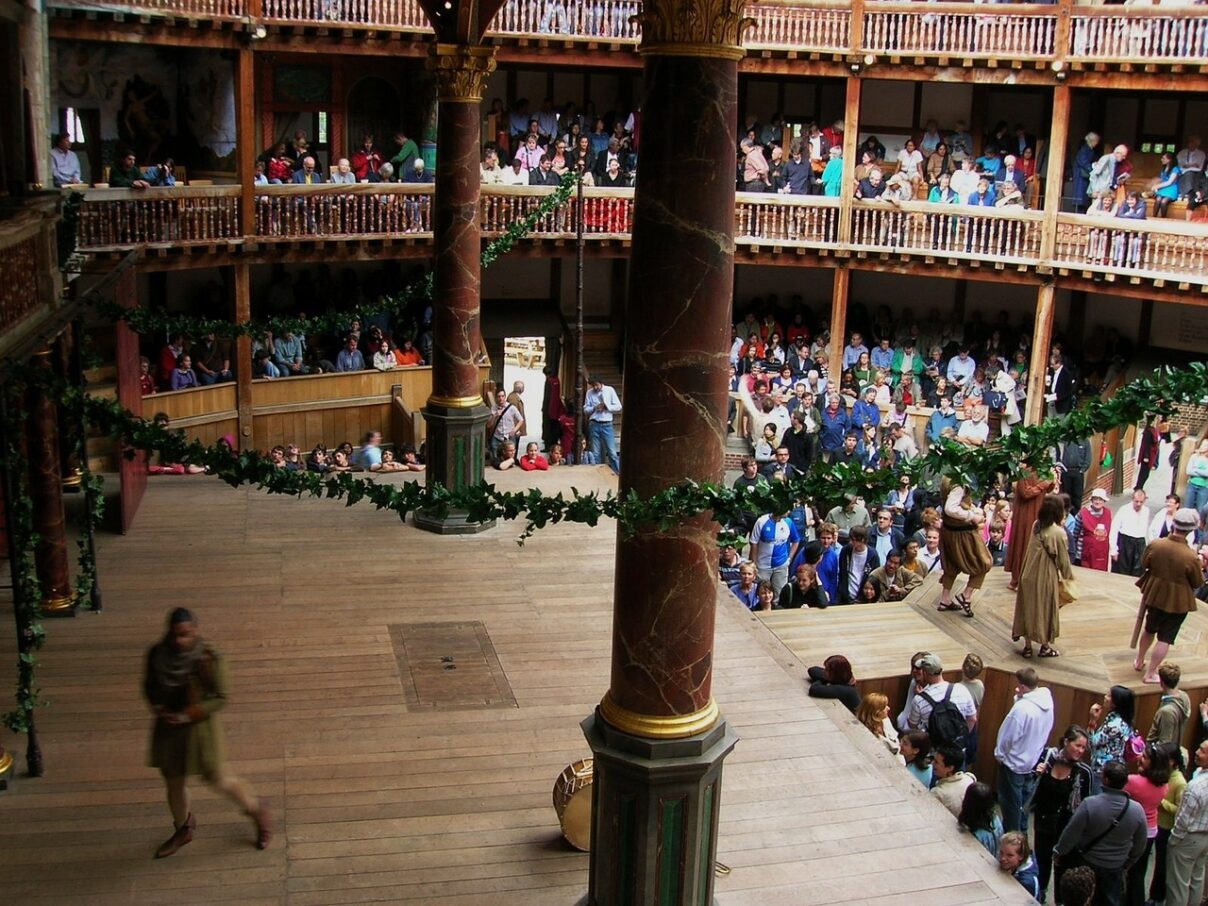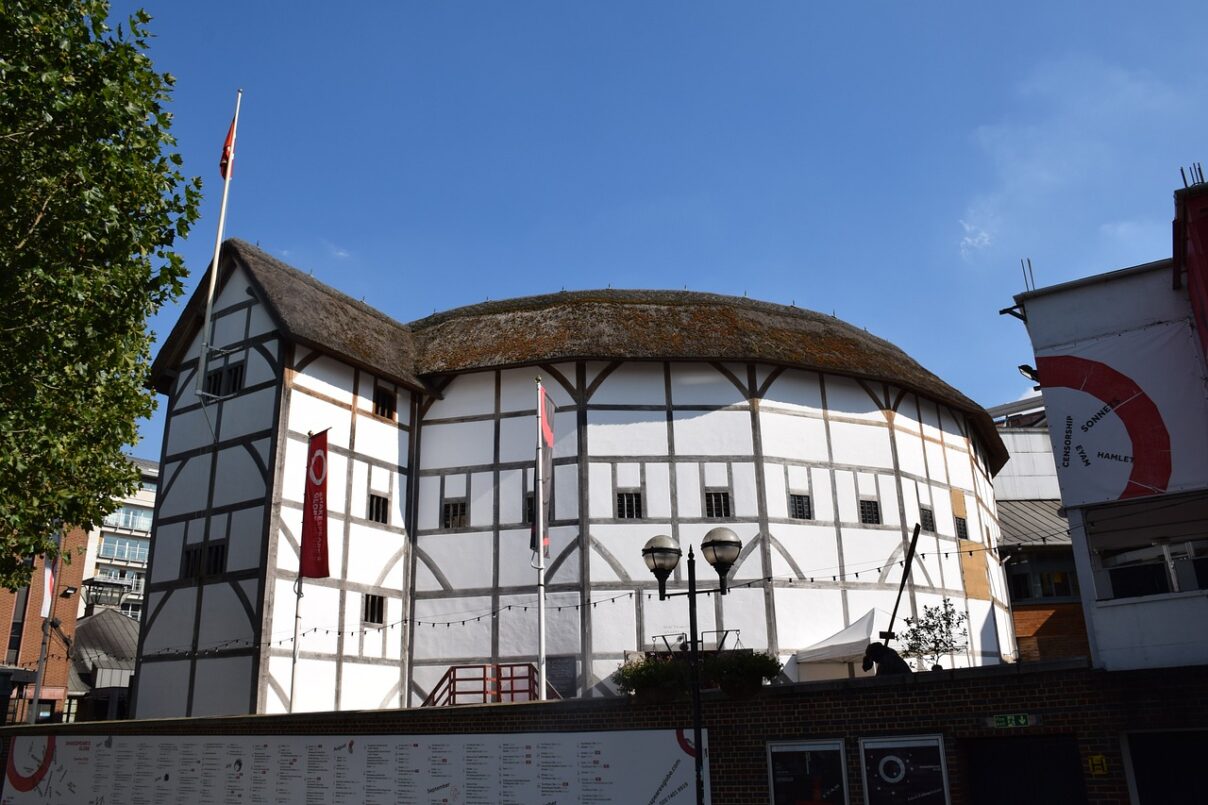What was it like to go to the theatre in Shakespeare’s time?
Professor Natalie Mears from our Department of History recently spoke to Jake Murray, Director of Elysium Theatre Company, about the political background to Shakespeare’s plays. Here we ask her about the experience of going to the theatre in Elizabeth’s and James’s reigns.

What theatres existed in the late sixteenth and early seventeenth centuries?
There were three broad sorts. First, there were theatrical productions at the royal court which took place around Christmas and New Year and Easter. There were no specially built theatres in the royal palaces until The Cockpit was built in 1629 so stages and seating were built and then taken down.
Second, there were public theatres. The first one — imaginatively called ‘The Theatre’ –opened in 1576 in Finsbury Fields, the area around what is now Finsbury Park Station but was then just fields and was not part of London. Other theatres were built to the south of the city, in Southwark. Public theatres were either amphitheatres, like The Globe, or posher ‘hall theatres’ with a stage at one end and then rows of seating. The cheapest ticket at a hall theatre was the same as the most expensive ticket at an amphitheatre.
Finally, there were outdoor and/or travelling troupes. These included the remnants of the old ‘Passion Plays’ of the Middle Ages, but there was also a new travelling troupe, The Queen’s Men, who were established under Elizabeth.
What was it like going to the theatre at the royal court? Did the monarch attend?
Yes, they did, though James was not a huge fan of the theatre – that was his wife, Anna of Denmark. The experience was very different from today. The whole room would have been brightly lit with candles, not just the stage. To sit in darkness would suggest that the monarch was too poor to buy candles – and it might have been dangerous!
Also, the main attraction was not the play but the monarch watching the play. Eyes would primarily be on him or her.
The main attraction was not the play but the monarch watching the play. Eyes would primarily be on him or her.
It may have been quite uncomfortable. We have a detailed plan of the scaffolding erected for a production in Oxford in the early seventeenth century. There were 200 ‘good’ seats, 350 ‘other’ seats and 810 standing places. It’s calculated that you had a maximum of 18 inches bum room – not much if you are wearing a big, wide dress! Perhaps standing was preferable!
It could also be really unruly. There were not only rails to stop courtiers getting too close to the monarch but we also have reports of court officials having to beat people back with their staves of office!
Sounds like it must have been better to go to the public theatre?
Possibly. If you were at The Globe, you obviously wouldn’t have to deal with the sound of aeroplanes flying into Heathrow like you do today, but it would have still been a hive of activity and noise. People would walk in and out, there were thieves, pickpockets and prostitutes all plying their trade.
If you were a bit of a show-off and could afford to go to a hall theatre, you could even sit on the stage while the play was on!

Do we know what the audience thought of plays?
Yes, we have some snippets. Queen Elizabeth was known for reading things into plays, especially about herself. William Cecil, Lord Burghley, once said that he didn’t know anyone else who could conjure up such obscure meanings and make everything about herself.
If she didn’t like something, she would also make it known. She walked out of a play in Cambridge early in her reign when the pope was being mocked (though she was a protestant); all the carriers of lanterns and torches went with her, leaving the actors in darkness.
Another time, when she was on progress in Coventry, she didn’t bother paying attention to the special performance of the traditional ‘Hock Tuesday’ play and it was noticed. She had to watch it again properly a couple of days later.
We have some fragments of evidence about more ordinary audience members. Someone who watched the play ‘Gorboduc’, that was performed at the Inns of Court and the royal court in the winter of 1561-2. The parts that they really noticed were the ‘dumb shows’, the little mimes at the beginning of each act that summarised the action to come. They interpreted one of these as meaning that Elizabeth should marry the known man (Robert Dudley, Earl of Leicester) not the unknown one (Eric XIV of Sweden). This was very different from the interpretation when the play was printed in 1570. Then it asserted that the ‘dumb show’ was about avoiding flattery.
Did they just get it wrong? Not necessarily. The explanation in the printed version in 1570 could have been changed to fit the time – a marriage to either Leicester or Eric was definitely off the cards by then. By contrast, marriage to either man were very much subjects of discussion in 1561-2 and there were other references to a Dudley marriage in some of the other entertainments put on at the Inns of Court at the same time.
Were plays and theatres popular?
They were with ordinary people but less so with the Corporation of the City of London or with puritans. They thought theatres were dens of iniquity that seduced young apprentices away from work and made them prey to prostitutes and pickpockets. This was why theatres were usually located outside the City, though that was also where marginalised people (like the poor, criminals, sex workers) were often pushed out to.
They thought theatres were dens of iniquity that seduced young apprentices away from work and made them prey to prostitutes and pickpockets.
Public theatres were closed down in 1642 with the outbreak of the Civil War. This was ostensibly to deal with pubic disorder but it would have pleased the puritan-dominated Parliament who had charge of the capital city.
They were not reopened until after the Restoration of the monarchy in 1660.
Any tips about studying early modern theatre?
One of the most important things I learned when I was doing my PhD and writing my first book was to be guided not by historians but by drama scholars. Though we rely on (usually printed) texts of plays, we have to remember that they were performances so we have to think about how they were performed and what the audience might have made of them – and recognise that audiences might not have been paying attention or might interpret a play in a very different way than they were ‘supposed’ to.
Find out more
- Natalie is a Professor (Early Modern British History) in the Department of History. View her staff profile.
- Hear Natalie’s thoughts on the political and historical background to Shakespeare’s plays in her episode of The Shakespeare Podcasts, a new series we are producing in collaboration with Elysium Theatre Company.
- Read more about the Shakespeare First Folio.
- Find out how we are celebrating Shakespeare this year at our Summer of Shakespeare festival.
- Visit our History webpages for more information on our undergraduate and postgraduate programmes.
- If you’d like to share your story or insights into your work, visit our Submit a blog or vlog page to learn more
